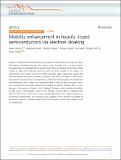Mobility enhancement in heavily doped semiconductors via electron cloaking
Author(s)
Zhou, Jiawei; Zhu, Hangtian; Song, Qichen; Ding, Zhiwei; Mao, Jun; Ren, Zhifeng; Chen, Gang; ... Show more Show less
DownloadPublished version (1.220Mb)
Publisher with Creative Commons License
Publisher with Creative Commons License
Creative Commons Attribution
Terms of use
Metadata
Show full item recordAbstract
<jats:title>Abstract</jats:title><jats:p>Doping is central for solid-state devices from transistors to thermoelectric energy converters. The interaction between electrons and dopants plays a pivotal role in carrier transport. Conventional theory suggests that the Coulomb field of the ionized dopants limits the charge mobility at high carrier densities, and that either the atomic details of the dopants are unimportant or the mobility can only be further degraded, while experimental results often show that dopant choice affects mobility. In practice, the selection of dopants is still mostly a trial-and-error process. Here we demonstrate, via first-principles simulation and comparison with experiments, that a large short-range perturbation created by selected dopants can in fact counteract the long-range Coulomb field, leading to electron transport that is nearly immune to the presence of dopants. Such “cloaking” of dopants leads to enhanced mobilities at high carrier concentrations close to the intrinsic electron–phonon scattering limit. We show that the ionic radius can be used to guide dopant selection in order to achieve such an electron-cloaking effect. Our finding provides guidance to the selection of dopants for solid-state conductors to achieve high mobility for electronic, photonic, and energy conversion applications.</jats:p>
Date issued
2022Department
Massachusetts Institute of Technology. Department of Mechanical EngineeringJournal
Nature Communications
Publisher
Springer Science and Business Media LLC
Citation
Zhou, Jiawei, Zhu, Hangtian, Song, Qichen, Ding, Zhiwei, Mao, Jun et al. 2022. "Mobility enhancement in heavily doped semiconductors via electron cloaking." Nature Communications, 13 (1).
Version: Final published version